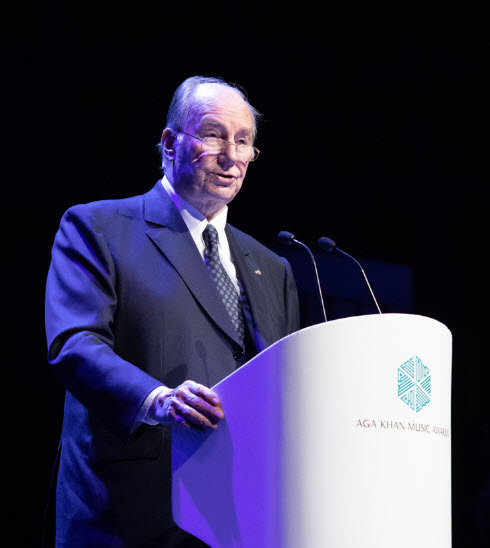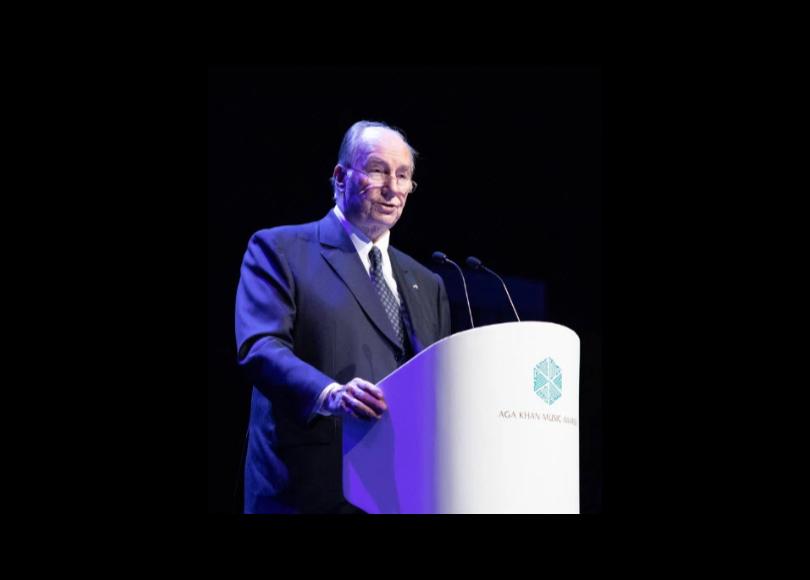“Now I know that in some parts of the world, the words “Muslim” and “music” are not often linked together in the public mind. But they should be… The cultural heritage of Islam has long embraced musical language as an elemental expression of human spirituality. Listening to music, practising music, sharing music, performing music – have long been an intimate part of life for Muslim communities across the world, as has been the chanting of devotional and historical or epic texts…every individual can respond to art and music, whether it emanates from a different culture or not. For after all, art is a matter of humanity just as much as it is a matter of identity. As the Islamic tradition has reminded us for many centuries, the Divine spark that bestows upon us our individuality also bonds individuals in a common human family.”
Mawlana Hazar Imam
Lisbon, Portugal, March 31, 2019
Speech

Islamic jurists have debated for centuries whether listening to music is unlawful, although it is not clear how the question arose as there is no direct censure against music in the Qur’an. There are just as many arguments in support of as there are against the listening of music being unlawful. Some jurists explain that singing is “unlawful” because it employs poetry, and they point to the Prophet condemning poets in Sura 31:5-6, where it says:
“There is one who purchases a ludicrous story, that he may seduce men from the way of Allah, without knowledge, and may laugh the same to scorn: these shall suffer a shameful punishment.”
The jurists argue that the “ludicrous story” meant singing. Another possible argument against the listening of music is Sura 26:224-6 which says:
“And the poets do those follow who go astray. Dost thou not see that they wander distraught in every vale?”
H.G. Farmer argues that “this was probably not directed against poetry as such, but simply against the poet who in the eyes of the Prophet was the incarnation of pagan idols, and who, was pouring out satires and invective against him” (A History of Arabian Music p 23). However, since objectors to listening to music could not find any real basis to discredit music listening, they turned to hadith, which was considered the second authority to the Qur’an. Farmer narrates that A’isha, the wife of the Prophet, has handed down a tradition that the Prophet once said, “Verily, Allah had made the singing girl (qaina) unlawful, and the selling of her and her price and teaching her” (A History of Arabian Music p 24).
Farmer states there are two hadiths in favour of listening to music: “Allah has not sent a Prophet except with a Beautiful Voice,” and “Allah listens more intently to a man with a Beautiful Voice reading the Qur’an than does a master of a singing-girl to her singing.” Anas ibn Malik (d. 715) claimed that Muhammad “used to make him sing the huda (caravan song) when travelling, and that Anjusha used to sing it for the women and Al-Bara ibn Malik (the brother of Anas) for the men. Al Ghazzali claims that the huda are poems equipped with agreeable sounds (sawat tayyiba) and measured melodies (alhan mauzuna)” (Ibid p 25). When the Prophet, who heard the voice of the singing girl and was asked if it were sinful to sing, the Prophet replied “Certainly not” (Ibid p 26).
Scholars agree that the Prophet tolerated musical instruments, and that his own marriage as well as that of his daughter, were celebrated with music. Historians suggest that the Prophet had to restrict the poetry of pagan Arabia and this was interpreted by some as the forbiddance of poetry. Many of the traditions were deeply embedded in the society at that time and the Prophet had to adapt to the social resistance and accept pagan customs under new sanctions (Ibid p 34).
Pagan Arabia had a custom of music during their festivals of feast, and this, too, says Farmer, “found a place in the public festivals connected with Islam, such as exists today in the ‘id aladha, the id al-fitr, the yaum ashura, and the various mawalid” (A History of Arabian Music p 35). Music was allowed during various celebrations such as births, weddings, and others. The lovesong, which had a strong tradition in pre-Islamic Arabia, was allowed.
Soon after the spread of Islam, cities of Mecca and Medina, “which were concentrations of political and religious power under the Orthodox caliphs, developed into important centres of rich musical life. Among the thousands of migrants to Arabia were many qualified artists and talented musicians, who had brought their craft with them. Patronised and generously rewarded by the elite, the best singers and instrumentalists could thus demonstrate their finest achievements.” (Shiloah, Music in the World of Islam p 11).
Many sources acknowledge that the founders of the four legal schools, the Hanafi, the Maliki, the Shafi’i, and the Hanbali, did not like listening to music, for a variety of reasons, and decided against its legality, although many treatises have been written to prove the opposite. Although there is no censure in the Quran, there are no conclusions whether listening to music is unlawful in Islam.
In pre-Islamic times, the oral recitation of poetry was the mark of artistic achievement “which has not been matched in subsequent periods” (Virani). At the time, the common form of poetry was the qasida – a long monorhyme (aa, ba, ca) in praise of someone although it was also used for preaching morals as well as, after the advent of Islam, to praise God and honour the Prophet and his family. An important aspect was the growing awareness of the potential expressiveness of the human voice, which was considered a reflection of the soul’s mysteries and feelings.
As Islam spread, the music of the community became entwined with the musical traditions of the conquered lands. The elite, who were enriched by the influx of wealth, sought amusement that was best expressed in music and song. The migrants brought their art and music with them, thereby influencing the cultures of the local peoples. As long as it did not contradict with Islamic teaching, the Arabs assimilated the new artistic forms creating unique styles. The musicians enjoyed high status as a result of increased importance given to musical activity by the wealthy rulers.
Further reading:
A tenth-century brotherhood discussed the healing qualities of music
In Knowledge Societies, the study of music was obligatory for the learned
Al-Tusi: “No relationship is nobler than that of equivalence as has been established in the science of music”
Pirs composed Ginans to teach Ismaili doctrines
Sources:
Ahmet T. Karamustafa, “Muslim Literature in Persian and Turkish,” The Muslim Almanac Edited by Azim A. Nanji
Amnon Shiloah, Music in the World of Islam, Wayne State University Press, Detroit,1995
Ellen Koskoff, Women and Music in Cross-Cultural Perspective, Greenwood Press Inc, Westport, 1987
Hanif Virani, “A Historical Sketch of Muslim Education,” Hikmat, July 1984
Henry George Farmer, A History of Arabian Music to the XIIIth Century, Luzac & Co. London, 1929
